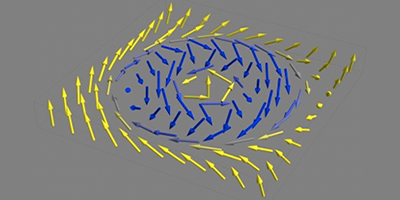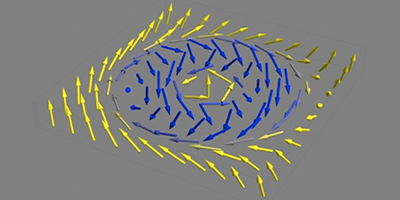Laser-Made Magnetic Vortices
Magnetic spins in a material can swirl around a single point in a stable particlelike configuration. These magnetic vortices, called “skyrmions,” may find use in future forms of computer memory. New experiments have generated these magnetic structures using laser pulses directed at a thin magnetic film. By varying the strength of the pulse, the researchers created individual skyrmions and even “molecules” made from multiple skyrmions, as detailed in Physical Review Letters.
A skyrmion can be thought of as a twist in a field, which can’t easily be unwound. The idea originated fifty years ago as a way to explain baryons, but it was superseded by the quark model. However, researchers have identified skyrmion states in other systems, including Bose-Einstein condensates and superconductors, where the field equations exhibit the characteristic skyrmion topology. Over the last few years, physicists have also demonstrated several types of magnetic skyrmions by exposing magnetic thin films to a strong external magnetic field.
The skyrmions produced by Marco Finazzi of the Polytechnic Institute of Milan, Italy, and his collaborators are unique in not requiring an applied magnetic field, neither for generation nor for stabilization. The team fired laser pulses at thin films of the ferrimagnetic alloy terbium-iron-cobalt (TbFeCo). They then mapped out the resulting magnetic spin configuration with optical microscopy. At relatively low laser energy, they observed -nanometer-wide cylindrically shaped skyrmions, in which the magnetization of the interior was opposite that of the exterior. Higher energy produced donut-shaped structures, which could be described as a skyrmion overlapping with an antiskyrmion (with opposite vortex circulation). The team called this moleculelike combination skyrmonium. These structures, as well as other more complex ones, did not noticeably change over one year of monitoring. The authors attribute this stability to the film’s own internal magnetic field. – Michael Schirber





